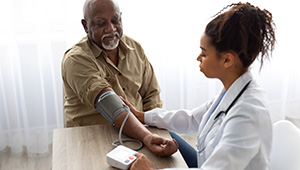August 2024 Dispatch for the CV Team
This month: intense exercise after stroke, rethinking Life’s Essential 8, why ACS patients should take part in trials, and more.

Every month, Section Editor L.A. McKeown curates a roundup of recent news tidbits from journals and medical meetings around the globe.
In patients who have heart failure with reduced ejection fraction (HFrEF) or moderately reduced/preserved ejection fraction (HFmrEF/HFpEF), dapagliflozin lowers the risk of CV death or worsening HF regardless of QRS duration, according to a pooled, patient-level post hoc analysis of the DAPA-HF and DELIVER trials. Investigators, writing in the European Journal of Heart Failure, say the absolute reduction in worsening HF events was particularly large in the high-risk subgroup of patients with a QRS duration ≥ 150 ms.
Fruits and vegetables may be more effective than oral sodium bicarbonate for reducing levels of dietary acid in patients with hypertension and macroalbuminuria, a study published in the American Journal of Medicine suggests. Researchers randomized 153 patients to 2-4 cups of base-producing fruits and vegetables daily in addition to their usual diet, twice-daily sodium bicarbonate, or usual medical care. At 5 years, the fruits/vegetables group and the bicarbonate group had improved kidney health relative to usual care, but only those eating added fruits and vegetables had reductions in blood pressure and improved indices of CVD risk. “Future clinical studies will determine if patients with levels of albuminuria less than macroalbuminuria are similarly responsive to dietary acid reduction,” the authors note.
 In the months and years following a stroke, patients may see more improvement in measures of fitness with high-intensity interval training (HIIT) than moderate-intensity exercise sessions, according to a study published in Stroke. Doing a HIIT regimen consisting of 1-minute intervals of high-intensity exercise, interspersed with nine 1-minute low-intensity intervals (19 minutes total) was found to be safe and feasible in 82 patients who had had a stroke within the previous 6 months to 5 years, and also led to greater gains in cardiorespiratory fitness measures than did 20-30 minutes of moderate-intensity exercise.
In the months and years following a stroke, patients may see more improvement in measures of fitness with high-intensity interval training (HIIT) than moderate-intensity exercise sessions, according to a study published in Stroke. Doing a HIIT regimen consisting of 1-minute intervals of high-intensity exercise, interspersed with nine 1-minute low-intensity intervals (19 minutes total) was found to be safe and feasible in 82 patients who had had a stroke within the previous 6 months to 5 years, and also led to greater gains in cardiorespiratory fitness measures than did 20-30 minutes of moderate-intensity exercise.
in JACC: Cardiovascular Interventions, a team from Germany describes what may be the first successful valve-in-valve tricuspid caval procedure in a heart transplant recipient. The 63-year-old patient, who was transplanted in 2009, developed recurrent right-sided HF due to severe tricuspid regurgitation caused by a septal leaflet flail. A caval procedure was considered a last resort after tricuspid transcatheter edge-to-edge repair (T-TEER) therapy and tricuspid transcatheter valve replacement (TTVR) were judged to be anatomically and technically not feasible.
 An updated meta-analysis of randomized trials of renal denervation (RDN) therapy in uncontrolled hypertension patients on and off antihypertensive drugs shows consistent reductions in 24‐hour ambulatory systolic BP, with low and similar rates of adverse events in RDN- and sham-treated patients. Published in the Journal of the American Heart Association, the study also shows a decrease in medication burden at 6‐month follow‐up in RDN patients.
An updated meta-analysis of randomized trials of renal denervation (RDN) therapy in uncontrolled hypertension patients on and off antihypertensive drugs shows consistent reductions in 24‐hour ambulatory systolic BP, with low and similar rates of adverse events in RDN- and sham-treated patients. Published in the Journal of the American Heart Association, the study also shows a decrease in medication burden at 6‐month follow‐up in RDN patients.
Adding a psychological health metric to the American Heart Association’s Life’s Essential 8 (LE8) can enhance the prediction of all-cause and cardiovascular mortality, a study published in the Journal of the American College of Cardiology: Advances suggests. The researchers say their data support potentially updating LE8 and propose the new name: Life’s Necessary 9. They add that “screening for and addressing depression, as a key CVD risk factor, with psychotherapy, behavioral, and pharmacological interventions as part of primordial prevention efforts may have a far-reaching effect for population-level reductions in mortality.”
 People who report having a lot of job stress may be at elevated risk of developing atrial fibrillation (AF) compared with those who are unaffected by stressors, a Canadian paper suggests. The study of nearly 6,000 white-collar office workers (mean age 45 years; 51% women) also found that AF risk was increased by more than 40% in people who perceived themselves to put in high levels of effort for low rewards in the form of income, respect and esteem, or occupational status. Writing in the American Heart Journal, the investigators say specific interventions are needed to target and prevent psychosocial stressors in office environments.
People who report having a lot of job stress may be at elevated risk of developing atrial fibrillation (AF) compared with those who are unaffected by stressors, a Canadian paper suggests. The study of nearly 6,000 white-collar office workers (mean age 45 years; 51% women) also found that AF risk was increased by more than 40% in people who perceived themselves to put in high levels of effort for low rewards in the form of income, respect and esteem, or occupational status. Writing in the American Heart Journal, the investigators say specific interventions are needed to target and prevent psychosocial stressors in office environments.
Compared with dual antiplatelet therapy (DAPT) consisting of clopidogrel and aspirin, a low-dose direct oral anticoagulant (DOAC) regimen for 3 months after percutaneous left atrial appendage occlusion (LAAO) was associated with a better balance of safety and efficacy in the small, randomized ADALA trial. Reporting the results in JAMA Cardiology, the ADALA investigators say the DOAC patients had less major bleeding and fewer thromboembolic events, including stroke, systemic embolism, and device-related thrombosis.
Patients in ACS trials may reap ongoing benefits in the form of lower risk of hospital readmission for cardiovascular causes. A study of more than 2 million ACS trial participants and nonparticipants utilizing the National Readmission Database and published in Cardiovascular Revascularization Medicine found no differences in unplanned 30-day readmissions between the two groups, but the imbalance in cardiovascular readmissions, the authors say, supports some lasting benefits of trial participation.
News Highlights From TCTMD:
Lp(a) Still Low Almost 1 Year After Last Olpasiran Injection: OCEAN(a)-DOSE
Going Contrast Free in TAVI Is Safe for CKD Patients
Initial US Commercial TriClip Cases Offer Hope, but Reimbursement Still a Big Question
L.A. McKeown is a Senior Medical Journalist for TCTMD, the Section Editor of CV Team Forum, and Senior Medical…
Read Full Bio


Comments